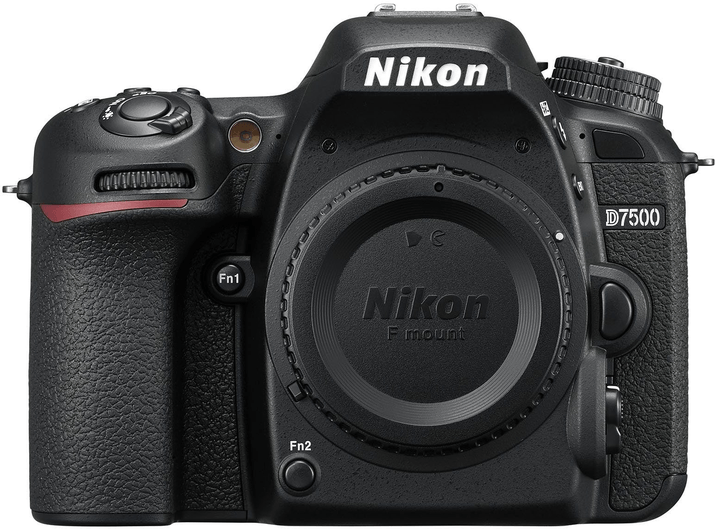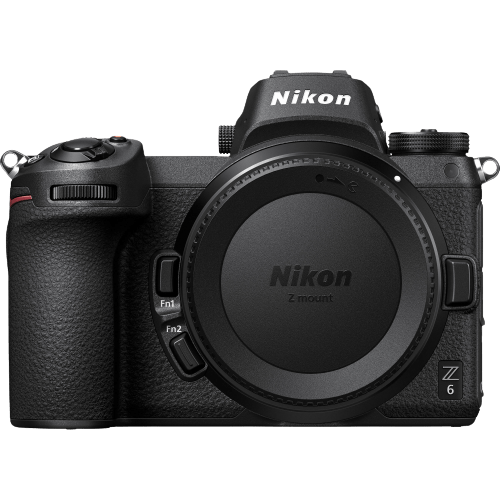Nikon D7500 vs Z6 Comparison
Nikon D7500

Nikon Z6

The Nikon Z6, with a score of 81/100, outperforms the Nikon D7500, which has a score of 70/100. Both cameras were released in 2017 and 2018, respectively, and share similar dimensions, with the Z6 being slightly smaller and lighter. The D7500 is a DSLR, while the Z6 is a mirrorless camera.
The Nikon Z6 excels in its compact size, weighing only 1.49lbs, and its superior score. These features make it a better option for those seeking a high-quality, portable camera. The Nikon D7500, on the other hand, has a lower launch price of $1250, making it a more budget-friendly option.
Taking these factors into consideration, the Nikon Z6 is the winner with its higher score and compact design. However, the Nikon D7500 remains a solid choice for those seeking a more affordable camera.
Nikon D7500 vs Z6 Overview and Optics
The Nikon Z6 surpasses the Nikon D7500 in optics with a score of 83/100 compared to the D7500’s 68/100. Both cameras share a CMOS sensor type, but the Z6 has a higher resolution at 24.5 megapixels compared to the D7500’s 20.9 megapixels. They also have different processors, with the Z6 utilizing the Expeed 6 and the D7500 using the Expeed 5.
The Nikon Z6 outperforms the D7500 in various aspects. With a faster shooting speed of 12 frames per second, the Z6 allows for better action and sports photography. Its full-frame sensor size results in better image quality and improved low-light performance. Moreover, the Z6 has a higher DXOMARK score of 95, indicating superior sensor performance. The Nikon Z lens mount offers compatibility with newer lenses, and the built-in image stabilization ensures sharper images in challenging conditions.
On the other hand, the Nikon D7500 has a few advantages. Its APS-C sensor size makes it compatible with a wider range of Nikon F DX lenses, which are generally more affordable than full-frame lenses. However, it lacks image stabilization and has a lower DXOMARK score of 86.
The Nikon Z6 is the clear winner in optics, offering better image quality, faster shooting speeds, and superior sensor performance. Its compatibility with newer lenses and built-in image stabilization make it a more versatile option for photographers. While the Nikon D7500 may have a wider range of affordable lens options due to its APS-C sensor size, it falls short in overall optical performance compared to the Z6.
Nikon D7500 vs Z6 Video Performance
The Nikon Z6 outperforms the Nikon D7500 in video capabilities, with a video score of 83/100 compared to the D7500’s 70/100. Both cameras share some common specifications, such as 4K maximum video resolution and 3840 x 2160 maximum video dimensions. They also both have built-in time-lapse functionality.
The Z6’s superior video capabilities can be attributed to its higher maximum video frame rate of 60fps, compared to the D7500’s 30fps. This allows the Z6 to capture smoother and more detailed video, especially in fast-paced or action-packed scenes. Additionally, the Z6’s higher video score indicates that it performs better in various video-related aspects, such as autofocus, color accuracy, and low-light performance.
On the other hand, the D7500 has some advantages over the Z6. Its lower video score does not necessarily mean it is an inferior camera overall. It may perform better in other aspects, such as photography or battery life. However, for the purpose of comparing video capabilities, the Z6 is the clear winner.
Considering the video capabilities of both cameras, it is evident that the Nikon Z6 is the superior choice for videographers and content creators who prioritize high-quality video performance. The Nikon D7500, while still a capable camera, may be better suited for photographers who do not require the advanced video features offered by the Z6.
Nikon D7500 vs Z6 Features and Benefits
The Nikon Z6 emerges as the winner with a feature score of 87/100, while the Nikon D7500 scores 83/100. Both cameras share several specifications, such as a 3.2-inch screen size, touchscreen functionality, and the absence of GPS. Additionally, both cameras have WIFI and Bluetooth capabilities.
The Nikon Z6 excels with a higher screen resolution of 2,100,000 dots, compared to the D7500’s 922,000 dots. This higher resolution provides a clearer and more detailed display for users, enhancing their photography experience. The Z6’s superior feature score showcases its overall better performance and capabilities, making it a more attractive option for photographers who prioritize high-quality displays.
On the other hand, the Nikon D7500 has a flip screen, which the Z6 lacks. This flip screen allows for more flexibility in shooting angles and is especially useful for vloggers or photographers who take self-portraits. Despite having a lower feature score, the D7500’s flip screen can be a deciding factor for users who value this particular feature.
In comparing the Nikon D7500 and the Nikon Z6, the Z6 takes the lead with its higher feature score and screen resolution, offering a better overall photography experience. However, the D7500’s flip screen advantage should not be overlooked, as it caters to specific user preferences. Ultimately, the choice between these two cameras depends on the individual needs and priorities of the photographer.
Nikon D7500 vs Z6 Storage and Battery
The Nikon D7500 triumphs over the Nikon Z6 in storage and battery with a score of 43/100 compared to the Z6’s 35/100. Both cameras have a single memory card slot; the D7500 accepts SD, SDHC, and SDXC cards, while the Z6 uses XQD cards. The D7500’s superior battery life allows for 950 shots per charge, utilizing the EN-EL15a battery type. In contrast, the Z6’s EN-EL15b battery lasts for only 310 shots. However, the Z6 has the advantage of USB charging, which the D7500 lacks.
The D7500’s longer battery life and compatibility with more common memory card types make it the better choice for extended shooting sessions and convenience. On the other hand, the Z6’s USB charging capability offers flexibility for on-the-go photographers. While the D7500 outperforms the Z6 in this category, the Z6 still holds value with its USB charging feature.
Nikon D7500 vs Z6 – Our Verdict
Are you still undecided about which camera is right for you? Have a look at these popular comparisons that feature the Nikon D7500 or the Nikon Z6:

